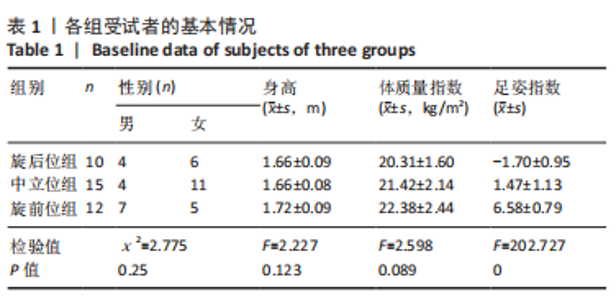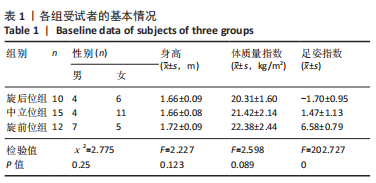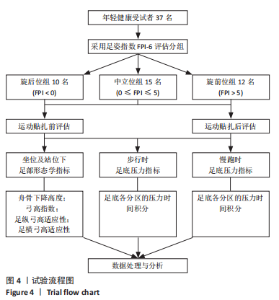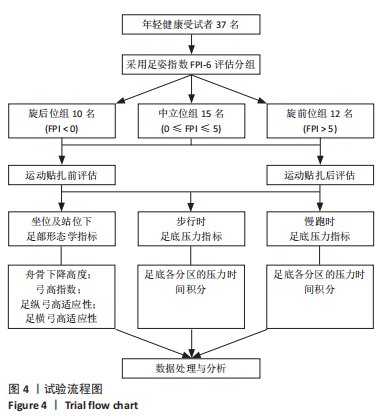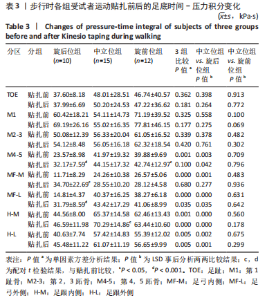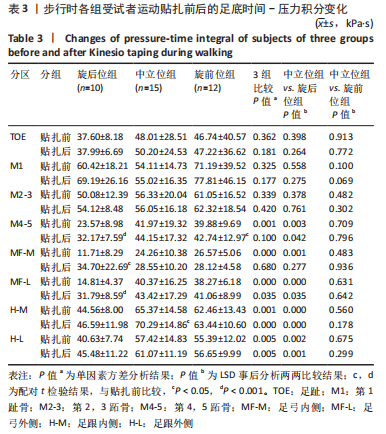Chinese Journal of Tissue Engineering Research ›› 2024, Vol. 28 ›› Issue (18): 2800-2807.doi: 10.12307/2024.051
Previous Articles Next Articles
Changes in plantar pressure of subjects with different foot positions during walking and jogging after Kinesio taping
Ke Jingyue1, Ma Shengnan1, Dong Hongming1, Li Jianping1, Zhang Honghao1, Liu Chao1, Liu Ruihao1, Li Guqiang2
- 1School of Rehabilitation, 2Rehabilitation Engineering Research Institute, Binzhou Medical University, Yantai 264003, Shandong Province, China
-
Received:2023-03-09Accepted:2023-04-18Online:2024-06-28Published:2023-08-24 -
Contact:Li Guqiang, Master, Professor, Rehabilitation Engineering Research Institute, Binzhou Medical University, Yantai 264003, Shandong Province, China -
About author:Ke Jingyue, Master candidate, School of Rehabilitation, Binzhou Medical University, Yantai 264003, Shandong Province, China -
Supported by:2021 Undergraduate Teaching Reform Research Project of Shandong Province, No. M2021213 (to LGQ); 2022 College Students’ Innovation and Entrepreneurship Training Program, No. 202210440067 (to LRH)
CLC Number:
Cite this article
Ke Jingyue, Ma Shengnan, Dong Hongming, Li Jianping, Zhang Honghao, Liu Chao, Liu Ruihao, Li Guqiang. Changes in plantar pressure of subjects with different foot positions during walking and jogging after Kinesio taping[J]. Chinese Journal of Tissue Engineering Research, 2024, 28(18): 2800-2807.
share this article
Add to citation manager EndNote|Reference Manager|ProCite|BibTeX|RefWorks
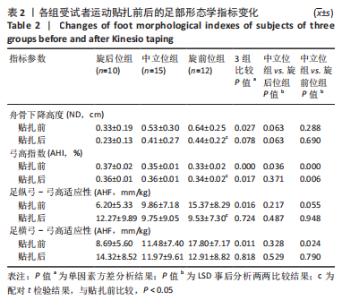
2.4 结局分析 2.4.1 足部形态学指标 根据组间方差分析的结果,贴扎前,各指标3组组间差异均有统计学意义(P < 0.05);贴扎后舟骨下降高度(ND)、足纵弓弓高适应性(AHF_LA)、足横弓的弓高适应性(AHF_TA),3组间的差异无显著性意义(P > 0.05),而弓高指数(AHI)的组间差异仍有统计学意义。两两比较的结果显示,运动贴扎后,旋后位组弓高指数(AHI)略增大,但仍小于中立位组(P < 0.05)。组内配对t检验结果,旋后位组、中立位组运动贴扎前后各指标的差异无显著性意义;对于旋前位组,足横弓的弓高适应性(AHF_TA)在贴扎前后差异无显著性意义,而舟骨下降高度(ND)与足纵弓弓高适应性(AHF_LA)显著减小、弓高指数(AHI)增加,贴扎前后差异有显著性意义(P < 0.05)。见表2。"
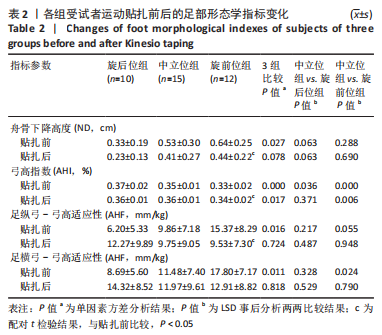
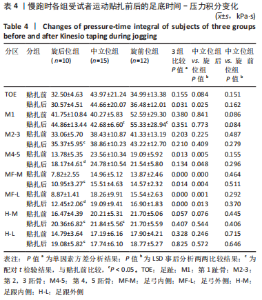
(1)组间方差分析:结果显示,运动贴扎前,于第4,5跖骨(M4-5)、足弓内侧(MF-M)、足弓外侧(MF-L)、足跟内侧(H-M)和足跟外侧(H-L)区域,3组组间压力时间积分差异均有显著性意义(P < 0.01);而贴扎后,上述区域中的第4,5跖骨(M4-5)、足弓内侧(MF-M)区域,3组组间差异变化无显著性意义(P > 0.05)。 (2)两两比较:结果显示,运动贴扎后,旋前位组第4,5跖骨(M4-5)区、足弓外侧(MF-L)区、足跟内侧(H-M)区、足跟外侧(H-L)区压力时间积分略增加,但仍小于中立位组(P < 0.01)。旋前位组足弓内侧(MF-M)区运动贴扎前压力时间积分显著小于中立位组(P < 0.01),贴扎后压力时间积分增加,与中立位组无显著差异(P > 0.05)。 (3)组内配对t检验:结果显示,旋后位组贴扎后,第4,5跖骨(M4-5)、足弓内侧(MF-M)、足弓外侧(MF-L)区域压力时间积分均显著增大(P < 0.05);中立位组贴扎后,足跟内侧(H-M)区域压力时间积分显著增大(P < 0.05);旋前位组贴扎后各区域与贴扎前比较差异均无显著性意义(P > 0.05)。 步行时3组受试者运动贴扎前后各区域的压力-时间积分的均值差见图5A,结果可见,运动贴扎前后,相比于中立位组及旋前位组,旋后位组中足区域、前足跖骨区域的压力时间积分变化更显著。 2.4.3 跑步时的足底压力分布变化 见表4。"
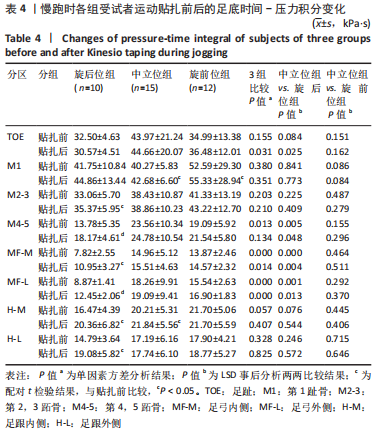
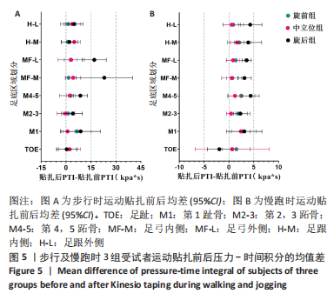
(1)组间方差分析:结果显示,运动贴扎前,于第4,5跖骨(M4-5)、足弓内侧(MF-M)、足弓外侧(MF-L)区域,3组组间差异均有统计学意义(P < 0.05);而贴扎后,上述区域中的第4,5跖骨(M4-5)区域的组间差异变化无显著性意义(P > 0.05),而足趾(TOE)区域出现显著差异(P < 0.05)。 (2)两两比较:结果显示,运动贴扎后,旋后位组足趾(TOE)区小于中立位组(P < 0.05)。运动贴扎前,旋后位组第4,5跖骨(M4-5)、足弓内侧(MF-M)、足弓外侧(MF-L)区压力时间积分小于中立位组(P < 0.05),运动贴扎后压力时间积分略增大,但仍小于中立位组(P < 0.05)。 (3)组内配对t检验:结果显示,旋后位组贴扎后,第2,3跖骨(M2-3)、第4,5跖骨(M4-5)、足弓内侧(MF-M)、足弓外侧(MF-L)、足跟内侧(H-M)和足跟外侧(H-L)区域压力时间积分均显著增大(P < 0.05);中立位组贴扎后,第1趾骨(M1)、足跟内侧(H-M)区域压力时间积分显著增大(P < 0.05);旋前位组贴扎后,第1趾骨(M1)区域压力时间积分显著增大。 慢跑时3组受试者运动贴扎前后各区域的压力-时间积分的均值差见图5B,结果可见,相比于中立位组及旋前位组,旋后位组在后足区域、中足区、前足跖骨区域及足趾区域变化更显著。"
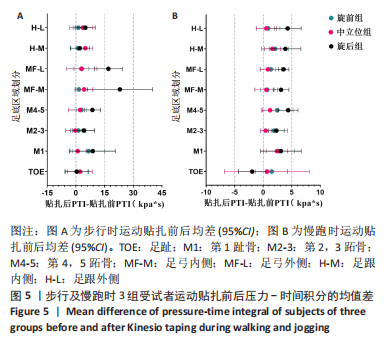
| [1] HILLSTROM HJ, SONG J, KRASZEWSKI AP, et al. Foot type biomechanics part 1: structure and function of the asymptomatic foot. Gait Posture. 2013;37(3):445-451. [2] UNVER B, ERDEM EU, AKBAS E. Effects of Short-Foot Exercises on Foot Posture, Pain, Disability, and Plantar Pressure in Pes Planus. J Sport Rehabil. 2019;29(4):436-440. [3] BIZ C, NICOLETTI P, TOMASIN M, et al. Is Kinesio Taping Effective for Sport Performance and Ankle Function of Athletes with Chronic Ankle Instability (CAI)? A Systematic Review and Meta-Analysis. Medicina (Kaunas, Lithuania). 2022;58(5):620. [4] SARVESTAN J, ATAABADI PA, SVOBODA Z, et al. The effect of ankle kinesioTM taping on ankle joint biomechanics during unilateral balance status among collegiate athletes with chronic ankle sprain. Phys Ther Sport. 2020;45:161-167. [5] 陈莉. 儿童柔韧性平足的生物力学特征及中西医结合康复干预评价研究[D].上海:上海中医药大学,2019. [6] 俞艳. 儿童拇外翻对于步态模式的影响及干预效果研究[D].上海:上海中医药大学,2020. [7] 朱胜群. 肌内效贴扎对大学生跑步中足弓稳定性维持的效果研究[D].上海:上海体育学院,2020. [8] CHEN TL, WONG DW, PENG Y, et al. Prediction on the plantar fascia strain offload upon fascia taping and low-dye taping during running. J Orthop Translat. 2019;20:113-121. [9] PÉREZ-MORCILLO A, GÓMEZ-BERNAL A, GIL-GUILLEN VF, et al. Association between the foot posture index and running related injuries: a case-control study. Clin Biomech (Bristol, Avon). 2019;61: 217-221. [10] AL ABDULWAHAB SS, KACHANATHU SJ. The effect of various degrees of foot posture on standing balance in a healthy adult population. Somatosens Mot Res. 2015;32(3):172-176. [11] YAMASHITA T, YAMASHITA K, SATO M, et al. Analysis of skeletal characteristics of flat feet using three-dimensional foot scanner and digital footprint. Biomed Eng Online. 2022;21(1):56. [12] TONG JW, KONG PW. Association between foot type and lower extremity injuries: systematic literature review with meta-analysis. J Orthop Sports Phys Ther. 2013;43(10):700-714. [13] IKUTA Y, NAKASA T, FUJISHITA H, et al. An association between excessive valgus hindfoot alignment and postural stability during single-leg standing in adolescent athletes. BMC Sports Sci Med Rehabil. 2022;14(1):64. [14] DESCHAMPS K, MATRICALI G A, DINGENEN B, et al. Foot and ankle kinematics in chronic ankle instability subjects using a midfoot strike pattern when running, including influence of taping. Clin Biomech (Bristol, Avon). 2018;54:1-7. [15] TANG M, WANG L, YOU Y, et al. Effects of taping techniques on arch deformation in adults with pes planus: a meta-analysis. PloS One. 2021;16(7):e0253567. [16] LUQUE-SUAREZ A, GIJON-NOGUERON G, BARON-LOPEZ FJ, et al. Effects of kinesiotaping on foot posture in participants with pronated foot: a quasi-randomised, double-blind study. Physiotherapy. 2014;100(1): 36-40. [17] AGUILAR MB, ABIÁN-VICÉN J, HALSTEAD J, et al. Effectiveness of neuromuscular taping on pronated foot posture and walking plantar pressures in amateur runners. J Sci Med Sport. 2016;19(4):348-353. [18] WELTE L, KELLY LA, LICHTWARK GA, et al. Influence of the windlass mechanism on arch-spring mechanics during dynamic foot arch deformation. J R Soc Interface. 2018;15(145):20180270. [19] VINICOMBE A, RASPOVIC A, MENZ HB. Reliability of navicular displacement measurement as a clinical indicator of foot posture. J Am Podiatr Med Assoc. 2001;91(5):262-268. [20] LANGE B, CHIPCHASE L, EVANS A. The effect of low-dye taping on plantar pressures, during gait, in subjects with navicular drop exceeding 10 mm. J Orthop Sports Phys Ther. 2004;34(4):201-209. [21] 白啸天,霍洪峰.足踝功能的生物力学测评:构建足静态和动态评价指标[J].中国组织工程研究,2021,25(17):2747-2754. [22] VENKADESAN M, YAWAR A, ENG CM, et al. Stiffness of the human foot and evolution of the transverse arch. Nature. 2020;579(7797):97-100. [23] CHOI HS, LEE JH. Immediate effect of balance taping using kinesiology tape on dynamic and static balance after ankle muscle fatigue. Healthcare (Basel). 2020;8(2):162. [24] KRAMER PA, LAUTZENHEISER SG. Foot morphology influences the change in arch index between standing and walking conditions. Anat Rec (Hoboken). 2022;305(11):3254-3262. [25] BROCKETT CL, CHAPMAN GJ. Biomechanics of the ankle. Orthop Trauma. 2016;30(3):232-238. [26] ELFTMAN H. The transverse tarsal joint and its control. Clin Orthop. 1960;16:41-46. [27] SANCHIS-SALES E, RODRÍGUEZ-CERVANTES PJ, SANCHO-BRU JL. Kinematics reduction applied to the comparison of highly-pronated, normal and highly-supinated feet during walking. Gait Posture. 2019; 68:269-273. [28] VT INMAN. The joints of the ankle. Williams & Wilkins Baltimore. 1977; 127(2):183. [29] KARAMANIDIS K, ARAMPATZIS A, BRÜGGEMANN GP. Reproducibility of electromyography and ground reaction force during various running techniques. Gait Posture. 2004;19(2):115-123. [30] CZERNIECKI JM. Foot and ankle biomechanics in walking and running. a review. Am J Phys Med Rehabil. 1988;67(6):246-252. |
| [1] | Li Zhifei, Yang Yin, Chen Hualong, Liang Qinqiu, Zhong Yuanming, Zhang Yisheng. Finite element analysis of the correlation between tilt angle of titanium cage and postoperative subsidence of titanium cage after anterior subtotal cervical corpectomy, decompression and fusion [J]. Chinese Journal of Tissue Engineering Research, 2024, 28(9): 1313-1319. |
| [2] | Chen Mengmeng, Bao Li, Chen Hao, Jia Pu, Feng Fei, Shi Guan, Tang Hai. Biomechanical characteristics of a novel interspinous distraction fusion device BacFuse for the repair of lumbar degenerative disease [J]. Chinese Journal of Tissue Engineering Research, 2024, 28(9): 1325-1329. |
| [3] | Liang Cheng, Zhang Linqi, Wang Guan, Li Wen, Duan Ke, Li Zhong, Lu Xiaobo, Zhuo Naiqiang. Finite element and biomechanical analysis of different implants in repair for unilateral unstable pelvic posterior ring injury [J]. Chinese Journal of Tissue Engineering Research, 2024, 28(9): 1336-1341. |
| [4] | Yang Junliang, Lu Tan, Xu Biao, Jiang Yaqiong, Wang Fucheng. Three-dimensional finite element analysis of effects of partial anterior cruciate ligament rupture on knee joint stress [J]. Chinese Journal of Tissue Engineering Research, 2024, 28(9): 1347-1353. |
| [5] | Weng Rui, Lin Dongxin, Guo Haiwei, Zhang Wensheng, Song Yuke, Lin Hongheng, Li Wenchao, Ye Linqiang. Abnormal types of intervertebral disc structure and related mechanical loading with biomechanical factors [J]. Chinese Journal of Tissue Engineering Research, 2024, 28(9): 1436-1442. |
| [6] | Wang Qiang, Li Shiyun, Xiong Ying, Li Tiantian. Biomechanical changes of the cervical spine in internal fixation with different anterior cervical interbody fusion systems [J]. Chinese Journal of Tissue Engineering Research, 2024, 28(6): 821-826. |
| [7] | Wei Yuanbiao, Lin Zhan, Chen Yanmei, Yang Tenghui, Zhao Xiao, Chen Yangsheng, Zhou Yanhui, Yang Minchao, Huang Feiqi. Finite element analysis of effects of sagittal cervical manipulation on intervertebral disc and facet joints [J]. Chinese Journal of Tissue Engineering Research, 2024, 28(6): 827-832. |
| [8] | Zhang Rui, Wang Kun, Shen Zicong, Mao Lu, Wu Xiaotao. Effects of endoscopic foraminoplasty and laminoplasty on biomechanical properties of intervertebral disc and isthmus [J]. Chinese Journal of Tissue Engineering Research, 2024, 28(6): 833-839. |
| [9] | Zhang Min, Peng Jing, Zhang Qiang, Chen Dewang. Mechanical properties of L3/4 laminar decompression and intervertebral fusion in elderly osteoporosis patients analyzed by finite element method [J]. Chinese Journal of Tissue Engineering Research, 2024, 28(6): 847-851. |
| [10] | Xue Xiaofeng, Wei Yongkang, Qiao Xiaohong, Du Yuyong, Niu Jianjun, Ren Lixin, Yang Huifeng, Zhang Zhimin, Guo Yuan, Chen Weiyi. Finite element analysis of osteoporosis in proximal femur after cannulated screw fixation for femoral neck fracture [J]. Chinese Journal of Tissue Engineering Research, 2024, 28(6): 862-867. |
| [11] | Huang Peizhen, Dong Hang, Cai Qunbin, Lin Ziling, Huang Feng. Finite element analysis of anterograde and retrograde intramedullary nail for different areas of femoral shaft fractures [J]. Chinese Journal of Tissue Engineering Research, 2024, 28(6): 868-872. |
| [12] | Wang Mingming, Zhang Zhong, Sun Jianhua, Zhao Gang, Song Hua, Yan Huadong, Lyu Bin. Finite element analysis of three different minimally invasive fixation methods for distal tibial fractures with soft tissue injury [J]. Chinese Journal of Tissue Engineering Research, 2024, 28(6): 879-885. |
| [13] | Hou Zexin, Xu Benke, Dai Yuan, He Chuan, Zhang Chaoju, Li Xiaolin. Finite element analysis of the mechanism of dorsiflexion injury of wrist joint in elderly people after falls [J]. Chinese Journal of Tissue Engineering Research, 2024, 28(6): 886-890. |
| [14] | Ning Tianliang, Wang Kun, Wang Lingbiao, Han Pengfei. Finite element analysis on correction effect of varus foot orthosis based on the three-point force principle [J]. Chinese Journal of Tissue Engineering Research, 2024, 28(6): 891-899. |
| [15] | Zhang Lili, Zhang Xinglai, Zhang Jie, Zheng Jiejiao. Effect of visual feedback on landing biomechanics in chronic ankle instability patients [J]. Chinese Journal of Tissue Engineering Research, 2024, 28(6): 900-904. |
| Viewed | ||||||
|
Full text |
|
|||||
|
Abstract |
|
|||||
